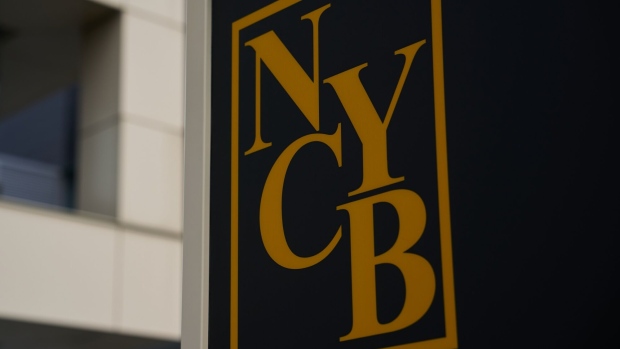May 1, 2024
NYCB’s Results Are Better Than Worst Fears After Rocky Quarter
, Bloomberg News

(Bloomberg) -- New York Community Bancorp Inc. shares jumped after the troubled lender posted results that were better than feared and executives outlined a plan for reshaping it into a more diversified and profitable bank.
Charge-offs and provisions for potential loan losses dropped in the first quarter from the previous three months, which could help allay commercial-property concerns that have hounded the lender since it last reported results. Under a new chief executive officer, the lender will seek to diversify its loan portfolio and bolster its funding profile with a goal of being profitable in 2025 following expected losses this year.
“Since taking on the CEO role, my focus has been on transforming New York Community Bank into a high-performing, well-diversified regional bank,” Chief Executive Officer Joseph Otting, who took over leadership of the company at the beginning of April, said in a statement. “While this year will be a transitional year for the company, we have a clear path to profitability over the following two years.”
Shares of the Hicksville, New York-based lender gained as much as 37%, their biggest increase in intraday trading in more than a year. The stock had plunged 74% this year through Tuesday.
NYCB took a $315 million provision for potential credit losses, more than analysts’ expectations of nearly $250 million yet still less than the prior quarter’s $552 million and the highest estimates. NYCB also wrote off more for bad loans in the first quarter than estimated, with net charge-offs totaling $81 million, but they came in lower than the fourth-quarter total as well.
The lender’s total deposits of $74.9 billion at the end of March were lower than the $77.2 billion given in an investor update earlier that month. Questions around the levels rose throughout the quarter as the bank grappled with rapid management changes, credit downgrades, stock volatility and banker exits.
‘Quite Early’
“While we are still quite early in this turnaround story, we believe shares are likely to move higher today from the smaller than feared deposit mix shift trend plus a formal three-year goal of profitability improvement,” Citigroup Inc. analyst Benjamin Gerlinger, who has a neutral rating on shares, wrote in a note to clients.
The results prompted an upgrade from Piper Sandler Cos. analyst Mark Fitzgibbon, who boosted his recommendation on shares to overweight from neutral and said the goals laid out by management offer meaningful upside for the stock.
“The plan is clear, uncomplicated and does not necessitate anything that we would consider to be a herculean lift,” he wrote.
In a presentation to investors Wednesday, NYCB outlined a strategy to transform the lender into a diversified bank, including aims to “develop a realistic operating plan” and focus on “rigorous credit-risk management.” In the medium term, the bank intends to diversify its loan portfolio toward less concentration and geographic risk, and improve its funding profile by increasing core deposits.
Discussing asset sales and the runoff of nonstrategic assets, management said on a conference call with analysts that the company is at the “doorstep” of a $5 billion transaction at par value, minus a transaction fee.
NYCB forecast a loss of 50 to 55 cents a diluted share for the full year, before restoring profitability next year. Guidance also included $750 million to $800 million of provisions for loan losses for 2024.
“We anticipate an elevated level of loan-loss provision over the remainder of 2024 related to the potential for market and rate conditions to impact borrower performance on certain portions of our loan portfolio,” Otting said in the statement.
Real estate owners are grappling with the fallout from higher borrowing costs and a shift in demand for properties such as offices. Refinancing property debt has become more challenging, in part because of higher rates and a pullback from lenders. And valuations have taken a hit, with office prices dropping 16% in the past year through March and apartment prices falling 8%, according to real estate data provider Green Street.
NYCB’s nonperforming commercial real estate loans more than doubled in the first quarter from the previous three months to $264 million. The bank also was a big lender to New York City’s rent-stabilized apartment market, which has come under pressure due to higher rates, costs and a 2019 rent law. NYCB said it conducted a due diligence process on those loans. In total, the bank’s multifamily loans considered nonperforming also more than doubled, to $339 million.
NYCB had been a relative winner among regional banks last year in the wake of its deal for parts of failed Signature Bank. That changed in January, when an earnings shock sent shares into a tailspin and ultimately drove the lender to seek a rapid capital injection.
The lender spooked investors when its fourth-quarter earnings report included a sharp dividend cut, higher provisions for credit losses than analysts expected and a surprise loss per share. The stock tumbled by a record 38% in one day amid concerns about deterioration in the lender’s property-loan portfolio.
In the weeks that followed, NYCB disclosed it had identified material weaknesses in its internal controls over loan review and switched CEOs. With the stock tumbling, a group of investors helmed by former Treasury Secretary Steven Mnuchin interceded to inject more than $1 billion of capital into the lender.
Otting was installed as CEO — the second time the bank’s leader was replaced in days — and Mnuchin and other investors joined the board. Otting was quick to shake up NYCB’s top ranks, including naming a new chief financial officer and head of commercial real estate lending.
--With assistance from Katherine Chiglinsky and Bill Haubert.
(Updates with latest shares, analyst upgrade starting in fourth paragraph.)
©2024 Bloomberg L.P.






